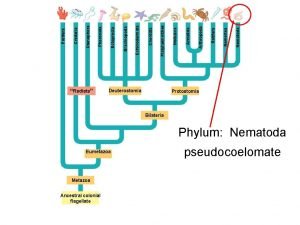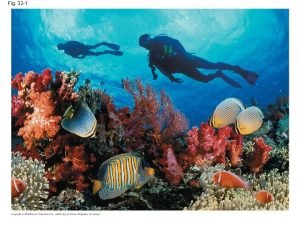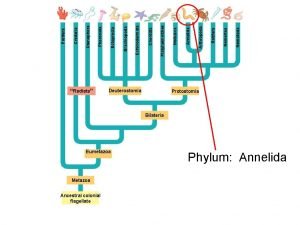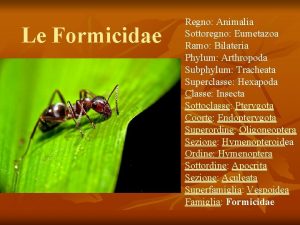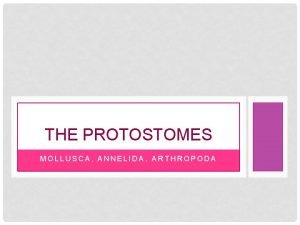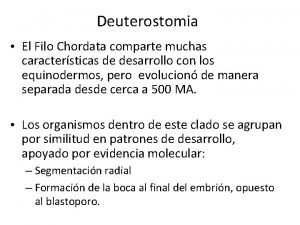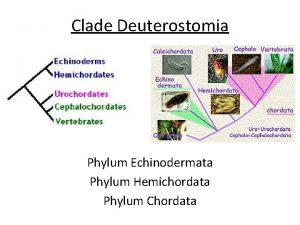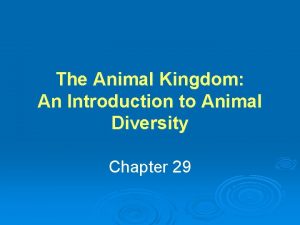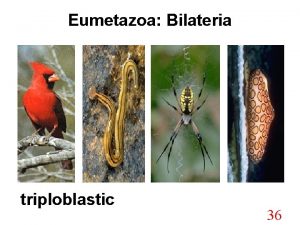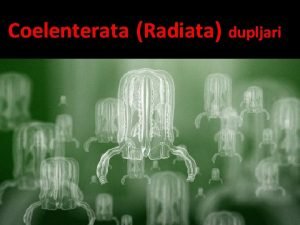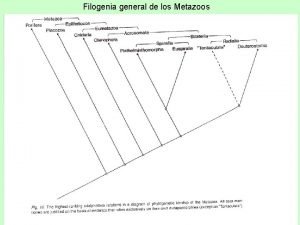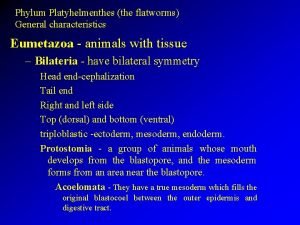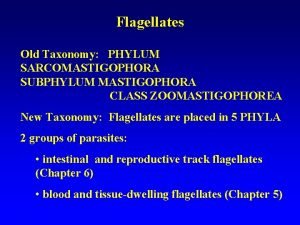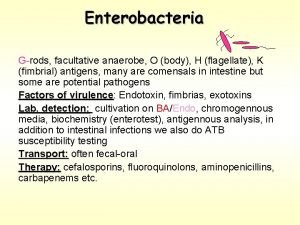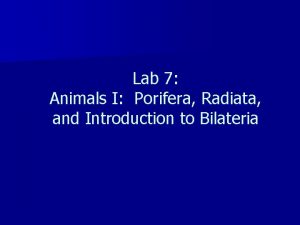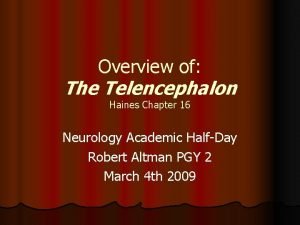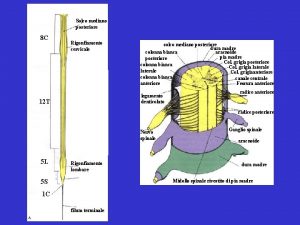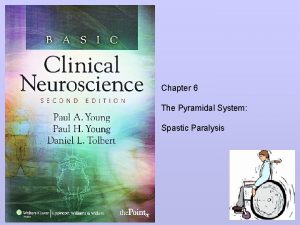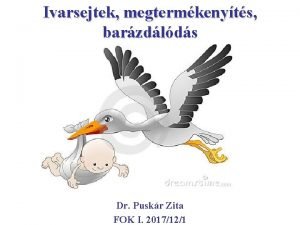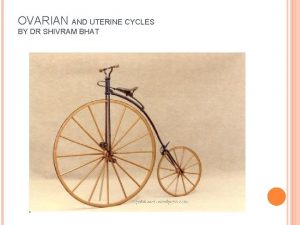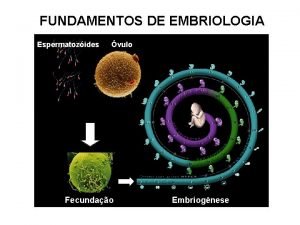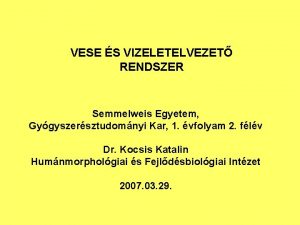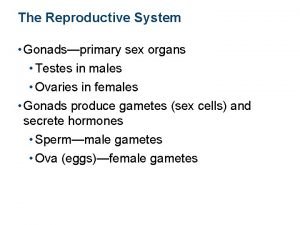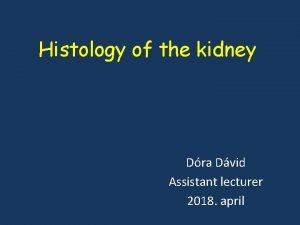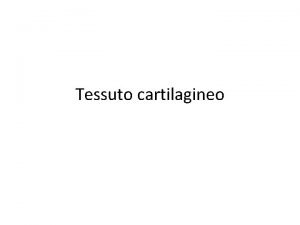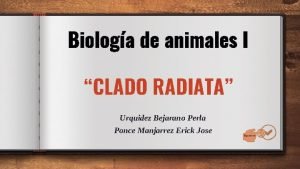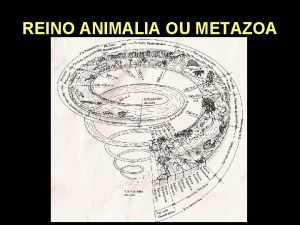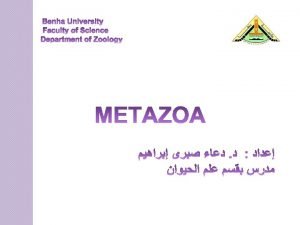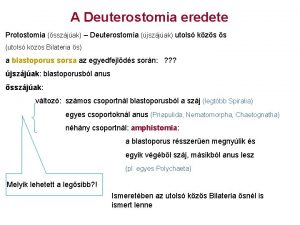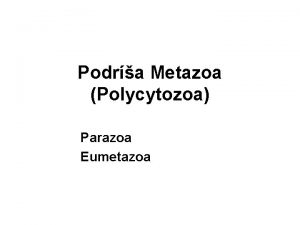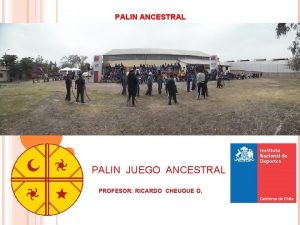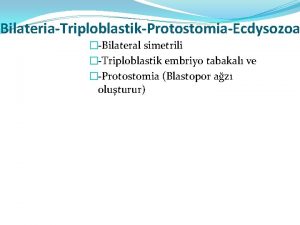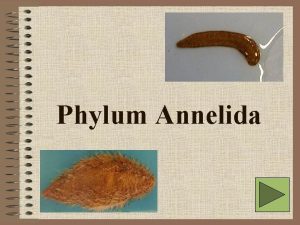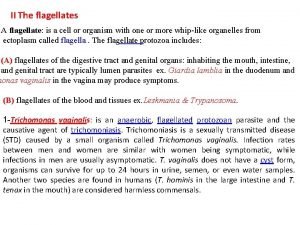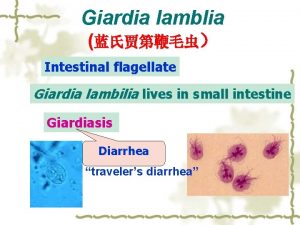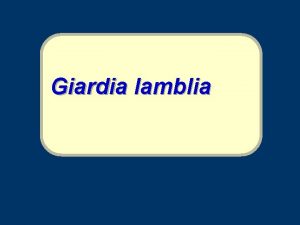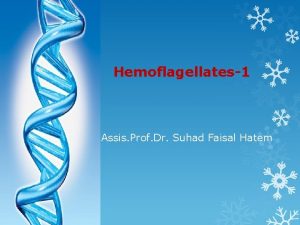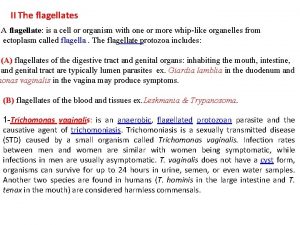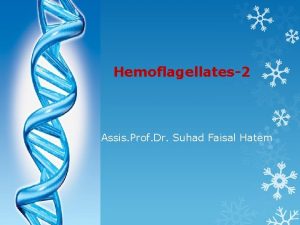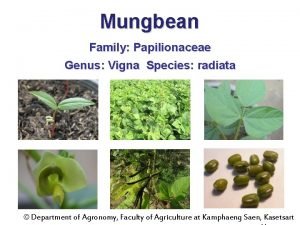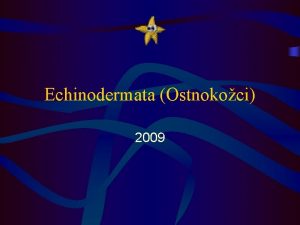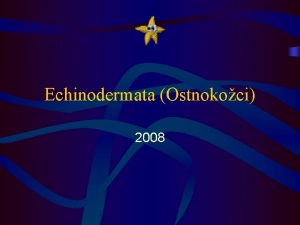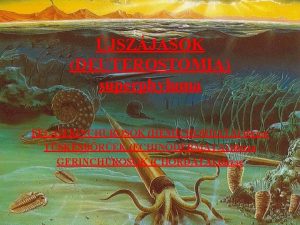Radiata Metazoa Ancestral colonial flagellate Deuterostomia Eumetazoa Protostomia






































- Slides: 38

“Radiata” Metazoa Ancestral colonial flagellate Deuterostomia Eumetazoa Protostomia Bilateria Phylum: Nematoda pseudocoelomate Nematoda Nemertea Rotifera Arthropoda Annelida Mollusca Platyhelminthes Chordata Echinodermata Brachiopoda Ectoprocta Phoronida Ctenophora Cnidaria Porifera

Kingdom: Animalia Phylum: Nematoda (formerly Aschelminthes) • non-segmented, smooth worms • tapered at both ends • bilateral symmetry • >80, 000 species described • most common soil inhabitant • 15, 000 parasitic species • most are <5 cm long • covered in thick, tough, protective cuticle • cuticle secreted by epidermis • molt several times during lifespan • triploblastic • pseudocoelomate- 1 st group to evolve a body cavity

Kingdom: Animalia Phylum: Nematoda (formerly Aschelminthes) pseudocoelomate- coelom partially lined with mesoderm

Advantages of Evolution of a Body Cavity • fluids moving in cavity can function as circulatory system • fluid in cavity makes body rigid allowing for muscle driven body movement, a “hydrostatic skeleton” • internal organs cushioned and protected from injury • organs can grow and move independently of outer body wall • food movement not controlled by locomotion of animal making digestion and waste removal more efficient

Kingdom: Animalia Phylum: Nematoda (formerly Aschelminthes) • complete digestive system • one-way digestive tract (has mouth & anus) • tube w/in a tube • nervous system • sensory structures and ganglia at head • nerve ring with ganglia around the pharynx • ventral and dorsal nerve cords • reproduction is sexual • most have separate males and females (dioecious) • reproductive organs in body cavity (pseudocoel) • females release chemical attractants

Kingdom: Animalia Phylum: Nematoda (formerly Aschelminthes) • locomotion • longitudinal muscles under epidermis • no circular muscles • can only undulate side-to-side (whip-like motion) • no cilia or flagella (not even on sperm) • “hydrostatic skeleton” aids in movement • excretory system • waste moved via fluid in body cavity • may have excretory ducts/pores as well as gland cells for waste removal • no respiratory or circulatory system • gas exchange by diffusion • food and nutrients distributed via fluid in body cavity

Kingdom: Animalia Phylum: Nematoda (formerly Aschelminthes) cross-section

Phylum: Nematoda, Genus: Ascaris lumbricoides • parasite of humans that causes ascariasis • largest intestinal roundworm (15 -35 cm) • can block intestine, bile duct, pancreatic duct • in tropical, sub-tropical areas with poor sanitation • caused by accidental ingestion of fertilized eggs • most common human helminth infection worldwide • infection easily treated with anti-helminthic drugs.

Phylum: Nematoda Hookworms hookworms attached to intestinal mucosa • adults attach to intestinal mucosa • feed on blood • can cause severe anemia • humans contract when larval form bores through skin after contact with contaminated soil

Phylum: Nematoda Pinworms • geographically found everywhere • common in school age children, spread by oral-fecal route • adult male 1 -3 mm, female 8 -13 mm • live in large intestine • ingested eggs hatch in small intestine, then migrate to large intestine to mature • eggs can survive 2 -3 weeks outside human body • treatment: anti-helminthic drugs kill larvae and adult, not eggs Beware the 10 second rule!

Phylum: Nematoda Trichinella spiralis causes trichinosis • larvae encysted in striated muscle • cysts formed by host immune response • larvae passed to another organism when undercooked meat is eaten • in new host, cyst digested in stomach releasing worm, then adult develops in intestine • adult worms deposit larvae in lymph vessels and wall of intestine • larvae migrate throughout body • larvae that make it to muscle encyst in their new host

Phylum: Nematoda Trichinella spiralis causes trichinosis • humans can get from eating undercooked pork • most damage of infection is when 1/2 billion larvae bore through the body at once • severe cramping, fever, anemia, weakness • may cause permanent muscular damage or death • prevention: thoroughly cook pork, freeze pork • rare in developed countries

Phylum: Nematoda Trichinella spiralis

Phylum: Nematoda Filaria worms • significant in human disease • intermediate host (vector) is arthropod • definitive host is a vertebrate • cause of. . . • elephantiasis in humans • heartworm in dogs

Phylum: Nematoda Filaria worms: Wuchereria bancrofti causes elephantiasis • found in tropical and subtropical areas • spread by bite of certain mosquitoes • adult worms live in lymphatic system • accumulate to large numbers and block lymph flow • causes fluid accumulation, swelling, especially in the lower extremities

filaria worms cause the disease elephantiasis

filaria worms cause the disease elephantiasis

Just FYI:

Phylum: Nematoda Filaria worm causes heartworm in dogs • intermediate host = mosquito • definitive host = dog • fatal to dog

“Radiata” Metazoa Ancestral colonial flagellate Deuterostomia Eumetazoa Protostomia Bilateria Phylum: Rotifera pseudocoelomate Nematoda Nemertea Rotifera Arthropoda Annelida Mollusca Platyhelminthes Chordata Echinodermata Brachiopoda Ectoprocta Phoronida Ctenophora Cnidaria Porifera

Kingdom: Animalia Phylum: Rotifera • microscopic • usually free-living, in moist soil or aquatic environments • pseudocoelomate • complete 1 -way digestive system • have excretory, nervous and reproductive systems • no circulatory or respiratory system

Kingdom: Animalia Phylum: Rotifera • corona • double crown of cilia at anterior end • look like rotating wheels when they beat • draw water current into mouth for feeding & locomotion • mastax • complicated muscular pharynx • seven hard jaw-like structures crush food • foot • at posterior end • when feeding, attaches to surface • nearby cement gland generates the adhesive

Kingdom: Animalia Phylum: Rotifera cilia beat in opposite directions to create current (cement glands)

Kingdom: Animalia Phylum: Rotifera • reproduction can be sexual or by parthenogenesis • parthenogenesis- in some species females produce 2 different kinds of diploid eggs, female and male, that develop without fertilization to diploid adults • in some species, eggs can develop as dwarf males that cannot even feed themselves, only survive long enough to produce sperm to fertilize females (sexual dimorphismsexes take on 2 different forms)

The Table for Nematoda: Symmetry: bilateral Segmentation: none Mesoderm present: yes, triploblastic, has only longitudinal muscles Type of body cavity: pseudocoelomate; fluid filled pseudocoel enclosed by cuticle forms hydrostatic skeleton Ciliated larva: have larva that molt (shed cuticle as they grow) Protostome: no? (this is under debate among scientists, newer molecular evidence may revise this) Cleavage/cells: determinate Nervous system: 2 nerve cords (dorsal & ventral) run length of body

1. Body Symmetry Asymmetric -different in every direction -sessile Radial -body parts arranged around a central axis -sessile or limited movement -able to meet “challenges” from every direction Bilateral -left/right sides are mirror images -has anterior (head) and posterior (tail) -encephalization (head formation) accompanied by concentration of sensory organs in that region -free moving -meet “challenges” head on

2. Body development- germ layers. How many? Three primary germ layers formed in the embryo, the ectoderm, mesoderm and endoderm, go on to form different tissues and organs in the developed animal. Not all animals have all 3 primary germ layers. Diploblastic- 2 layers -have ectoderm and endoderm -no mesoderm -ex. jellies, corals Triploblastic- 3 layers -have ectoderm, mesoderm and endoderm -all animals with bilateral symmetry

2. Body development- germ layers- How many? 2 Only one cleavage 1 The zygote of an animal undergoes a succession of mitotic cellstage–the eight-cell embryo–is shown here. divisions called cleavage. 3 In most animals, cleavage results in the formation of a multicellular stage called a blastula. The blastula of many animals is a hollow ball of cells. Blastocoel Cleavage 6 The endoderm of the archenteron develops into the tissue lining the animal’s digestive tract. Zygote Eight-cell stage Blastula Cross section of blastula Blastocoel Endoderm 5 The blind pouch formed by gastrulation, called the archenteron, opens to the outside via the blastopore. Ectoderm Gastrula Blastopore Gastrulation 4 Most animals also undergo gastrulation, a rearrangement of the embryo in which one end of the embryo folds inward, expands, and eventually fills the blastocoel, producing layers of embryonic tissues: the ectoderm (outer layer) and the endoderm (inner layer). Figure 32. 2 *Archenteron becomes gut

2. Body development- germ layers- How many? Diploblastic (2) vs. Triploblastic (3) ectoderm -outermost germ layer -forms animal’s outer covering, in some phyla central nervous system endoderm -innermost germ layer -forms lining of digestive tract, in vertebrates forms liver, lungs Coelom Archenteron Mesoderm Coelom Blastopore Mesoderm mesoderm -between ectoderm/endoderm in triploblast -forms muscles between digestive tract and animal’s outer covering

3. Body development- fate of blastopore Does it develop “mouth first” or “mouth second”? Coelom Archenteron Coelom Blastopore Mesoderm Mouth Anus Digestive tube Mouth develops from blastopore Protostome -“mouth-first” -ex. mollusks, annelids Deuterostome -“mouth-second” -aka “bum-first” -ex. echinoderms, vertebrates Anus develops from blastopore *Archenteron becomes gut

4. Body Cavity Type Acoelomate Body covering (from ectoderm) (c)Acoelomates such as flatworms lack a body cavity between the digestive tract and outer body wall. Digestive tract (from endoderm) Tissuefilled region (from mesoderm)

4. Body Cavity Type Pseudocoelomate Body covering (from ectoderm) (b)Pseudocoelomates such as nematodes have a body cavity only partially lined by tissue derived from mesoderm. Pseudocoelom Digestive tract (from ectoderm) Muscle layer (from mesoderm)

4. Body Cavity Type body cavity (coelem)- space between gut and body wall; present in most triploblasts (have mesoderm) but not diploblasts (lack mesoderm Coelomate Coelom (a)Coelomates such as annelids have a true coelom, a body cavity completely lined by tissue derived from mesoderm. Tissue layer lining coelom and suspending internal organs (from mesoderm) Digestive tract (from endoderm) Figure 32. 8 a Body covering (from ectoderm)

Advantages of Evolution of a Body Cavity • fluids moving in cavity can function as circulatory system • fluid in cavity makes body rigid allowing for muscle driven body movement, a “hydrostatic skeleton” • internal organs cushioned and protected from injury • organs can grow and move independently of outer body wall • food movement not controlled by locomotion of animal making digestion and waste removal more efficient

5. Cleavage- determinate vs indeterminate (In humans, the first few divisions are indeterminate. If cells in the embryo separate within the first divisions, the result is identical twins. )

Cleavagespiral & determinate vs. radial & indeterminate Protostome development (examples: molluscs, annelids, arthropods) Eight-cell stage Deuterostome development (examples: echinoderms, chordates) Eight-cell stage Spiral and determinate Radial and indeterminate =

Digestive system: complete 1 -way system (mouth & anus); muscular pharynx; some heterotrophs, many are parasites Excretory system: excretory ducts & pores to eliminate waste, some have gland cells and/or canal systems, too Reproductive system: sexes usually separate (dioecious); male reproductive tract opens to rectum forming common exit called the cloaca; female reproductive tract opening separate from digestive tract Circulatory system: none Members: hookworms, pinworms, common roundworm, trichinella Habitat: moist soil; the most numerous inhabitant of the soil; also found in aquatic environment; some parasites Relationship to other phyla: N/A

The Table for Rotifera: (If nothing is listed for a category, assume it is the same as for Nematoda. ) Reproductive system: sexual or by some by parthenogenesis (produce diploid eggs that grow to diploid adult without fertilization); some exhibit sexual dimorphism producing degenerate dwarf males that live only long enough to fertilize eggs Members: rotifers Habitat: freshwater and marine environments, moist soil Relationship to other phyla: cuticle suggests rotifers are close relatives of roundworms
 Protostoma
Protostoma Nematoda
Nematoda Ancestral colonial flagellate
Ancestral colonial flagellate Protostomia
Protostomia Ancestral colonial flagellate
Ancestral colonial flagellate Ancestral colonial flagellate
Ancestral colonial flagellate Formiche rufe
Formiche rufe Mollusca annelida arthropoda
Mollusca annelida arthropoda Filo
Filo Clado deuterostomia
Clado deuterostomia Deuterostomia
Deuterostomia Eumetazoa phylum
Eumetazoa phylum Eumatozoa
Eumatozoa Coronatae
Coronatae Nefroducto
Nefroducto Eumetazoa characteristics
Eumetazoa characteristics Parabasal body
Parabasal body Flagellate rods
Flagellate rods Perkawinan antara dua ekor tikus yang dipotong ekornya
Perkawinan antara dua ekor tikus yang dipotong ekornya Pyrimidal system
Pyrimidal system Radiata animals
Radiata animals Lobi e lobuli renali
Lobi e lobuli renali Corona radiata
Corona radiata Fascicolo cuneato
Fascicolo cuneato Spinomedullary junction
Spinomedullary junction Kapacitáció
Kapacitáció Ovarian cycke
Ovarian cycke Pars radiata corticis
Pars radiata corticis Vulo
Vulo Interlobaris
Interlobaris Fase luteale
Fase luteale Where is the cliturous located diagram
Where is the cliturous located diagram A corticalis radiata
A corticalis radiata Zona radiata cartilagine
Zona radiata cartilagine Scleroctenophora
Scleroctenophora Claudia montanari radiata
Claudia montanari radiata Subkingdom protozoa
Subkingdom protozoa Metanefrídio
Metanefrídio Subkingdom metazoa
Subkingdom metazoa



